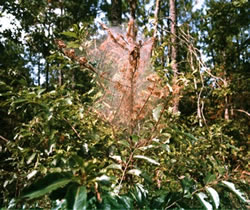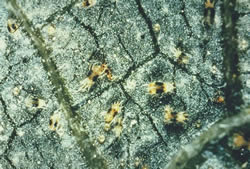Search
For The Answer
Click here to access our database of
Plant Answers
Search
For The Picture
Click here to access the Google database of plants
and insects
Information
Index
Alphabetical Listing of Topics, Recommendations
and Plants
Milberger's Nursery and Landscaping
3920 North Loop 1604 E.
San Antonio, TX 78247
210.497.3760
nursery@milbergersa.com
Open 9 to 6 Mon. through Sat.
and 10 to 5 on Sun.

Three exits east of 281, inside of 1604
Next to the Diamond Shamrock station
Please click map for more detailed map and driving directions.
Express-News Weekly Column
Saturday, June 21, 2003
Submitted by Calvin Finch,
Ph.D., Manager, Conservation Division, Water Resources & Conservation
Department, SAWS, and Horticulturist
BUGS AND OTHER MALADIES
 |
 |
It is time to describe some of the “plant problems” that are occurring in the San Antonio area now so that you can treat those that need action and be reassured that there is nothing you need to do on some of the other symptoms.Leaves from many species of trees are dropping. The rain last week will help reduce the leaf drop, but it is a normal phenomenon most years at this time. The crowns fill out during the relatively cool, wet weather of spring. When the hot, dry weather of the summer settles in, the trees adjust the leaf load to a level that the tree can support with dry soil and hot temperatures. No treatment is necessary. Increasing irrigation is not helpful because it results in unnecessary water use. The leaf load should be allowed to be adjusted. The tree’s health is not threatened.
If you are trying to grow tomatoes or eggplants this spring, you have probably seen the symptoms caused by spider mites. The little (pinpoint-size) relatives of spiders suck the juices from the undersides of leaves of many species of plants. If the infestation becomes heavy, the leaves assume a dusty, mottled look. In severe cases, the leaves look torched and spider-like webs are everywhere on the plant.
Spider mites are difficult to combat. Some insecticides/miticides are labeled for use. Orthene works fairly well for non-food plants but cannot be used on vegetables. A stream of water under pressure directed at the bottom of the leaves every three or four days provides some control. Neem oil applied in the same way improves control. The key is to get good coverage under the leaves and to apply the spray frequently. In hot weather the spider mite generation time is every three or four days.
Spider mites are one of the reasons that we recommend that tomato plants be pulled from the garden at the end of June. The chance of infestation increases as the summer progresses.
Dry-looking spots in your zoysia or Bermuda grass can be just that, dry spots. When it is very hot and your irrigation system does not distribute the water equally or you have compacted or thin spots in the soil, your lawn grass will go dormant at those locations. The best way to address the dry spots is to hand water once per week at the dry area. Using the hand watering option is less expensive than adding extra unnecessary water to the whole lawn by increasing the sprinkler time.
In some situations, the dry-looking spots have turned out to be brown patch. Despite the hot days, we have had spells of cool nights with the result that the fungus disease has developed on lawns where watering has been heavy. The best treatment is to cut back to one irrigation cycle per week. Brown patch requires moisture to develop. A lawn that is on the dry side is less likely to be infected.
“Take-All Patch” is also a fungus disease that produces symptoms that look like dry spots. Unlike brown patch and “real” dry spots, however, the roots are dead as well as the top. If you have a spot that is round like typical fungal infection and the roots are dead, it is probably “Take All Patch.” This is an especially hard disease to cure. Recent research from A & M indicates that compost applied on and around the dead area will cure the fungus over a period of months. A product called HuMore was specifically mentioned in the research. It is a cottonseed and manure-based compost product. The good news is that it is inexpensive by the bag (about $6) and available at area retail nurseries.
Webworms are obvious in pecans and mulberries at scattered locations around the city. If the infestations are low in the tree, spraying a Bt product like Dipel, Thuricide, or Bio-Worm Control is practical but, in many cases, the webs are very high in the tree. Open the webs that you can reach with a cane pole to make them vulnerable to attack by wasps and the hot weather. It is best just to ignore the high webs. The worms will strip some leaves and the webs are ugly, but they will not kill the tree. If you have other “plant problems” that you would like to have diagnosed, call Jerry Parsons and me on “Gardening South Texas” (308-8867, from noon until 2 p.m. on Saturdays and 1 until 3 p.m. on Sundays, KLUP 930 AM) or visit our website plantanswers.com.




